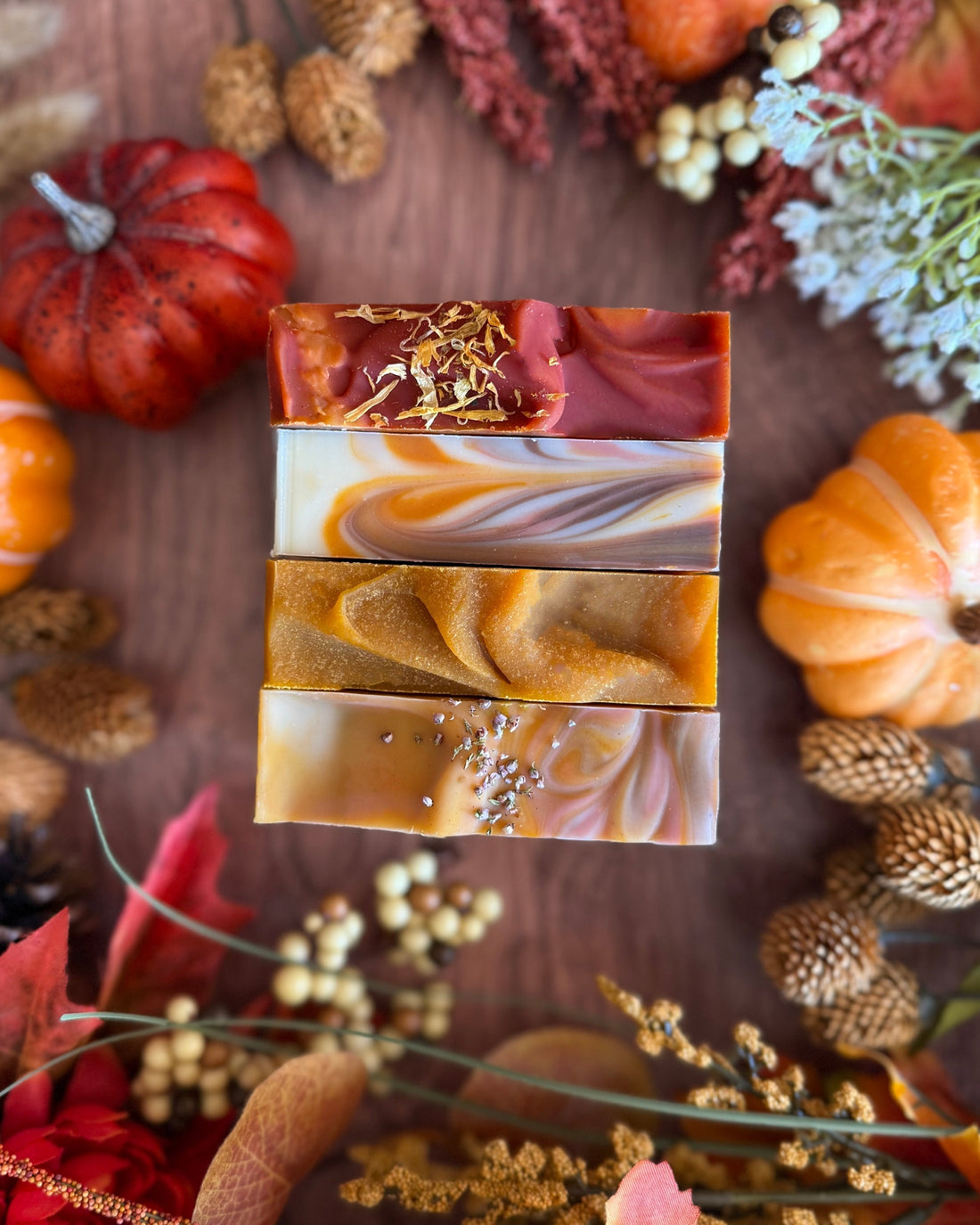If you’ve ever browsed handmade natural soaps and wondered why they cost more than the commercial bars at the store, you’re not alone. One of the biggest questions I hear is: How much does handmade soap cost—and is it worth it?
In 2025, handmade soap typically costs anywhere between $7 and $12 per bar. That price might seem higher compared to a $2 store-bought bar, but when you look at what goes into handcrafted soap, the difference makes sense. Let’s dive into what sets handmade soaps apart, why they carry a higher price tag, and why they’re worth every penny.
What Sets Handmade Natural Soaps Apart?
Premium Ingredients
Handmade soaps are made with quality oils, butters, clays, and pure essential oils. I carefully choose ingredients like olive oil, coconut oil, shea butter, and botanicals because they’re nourishing for the skin and free from harsh chemicals. Many commercial soaps use cheap fillers, detergents, and synthetic fragrances that can dry out your skin. With handmade soap, you’re paying for clean, skin-loving ingredients.
Artisan Craftsmanship
Every handmade bar is crafted in small batches with care and attention to detail. I’ve always loved swirling natural colors together and blending essential oils to create soaps that are as beautiful as they are functional. Unlike mass-produced bars, each soap feels unique—no two batches ever turn out exactly the same. A detailed guide on the history and techniques used by expert artisans can be found here.
Ethical and Sustainable Practices
Most handmade soap makers (including me!) value eco-friendly packaging, sustainable sourcing, and reducing waste. For example, I use recyclable packaging and natural colorants instead of artificial dyes. When you buy handmade, you’re supporting small businesses that care about the planet as much as your skin.
The Benefits of Handmade Soap:
Skin Health
One of the biggest differences is glycerin. Commercial soap manufacturers often strip glycerin from their bars to sell it for lotions, which is why your skin can feel dry afterward. Handmade soap keeps the natural glycerin intact, which means your skin feels hydrated, soft, and nourished after every wash.
Unique Scents and Colors
Handmade soaps aren’t just functional—they’re a treat for your senses. We use only pure essential oils to create the most natural, amazing scents—no synthetic fragrance oils at all. From cozy fall blends like Pumpkin Spice to refreshing Citrus, calming Lavender, and detoxifying Charcoal, each soap is carefully crafted to smell incredible while caring for your skin. We also get creative with natural colorants that provide skin-loving benefits: alkanet root for purple, annatto for yellow, rose clay for pink, and alfalfa powder for green. The result is beautifully swirled, vibrant soaps that are true works of art. Made with only the most natural ingredients, our soaps are not only visually stunning but also healthy, nourishing, and toxin-free.
A Greener Choice-
Handmade soaps usually come in minimal, eco-friendly packaging and are made with biodegradable ingredients. Choosing them is a small but powerful step toward sustainable living. Choosing all-natural, handmade soap not only give you a unique scent and customized experience but is also healthier for your body and the environment. Learn more about the benefits of handmade soap here.
Comparing Costs:
Yes, handmade soap costs more than commercial soap. But when you consider the quality of ingredients, ethical production, and skin benefits, the price is more like an investment in your health and well-being.
Plus, if you use a draining soap dish to let your bar dry between uses, a handmade bar can last longer than you’d expect—sometimes outlasting two or three store-bought bars.
So, Is Handmade Soap Worth the Cost?
The real question isn’t just How much does handmade soap cost? but rather What am I getting for that cost?
When you choose handmade natural soaps, you’re not just buying soap. You’re choosing:
- Non-toxic, skin-loving ingredients
- Artisan craftsmanship that makes each bar unique
- Eco-friendly practices that support sustainability
- A product that feels like a little bit of luxury in your daily routine
From my own experience as a soap maker, I can tell you that every bar I make is designed with love and intention. When customers switch to handmade soap, they often come back saying their skin feels better, they love the scents, and they’ll never go back to commercial bars.
Ready to make the switch? Shop all natural soaps here: Ashley Marie Soap Collection. They’re worth the cost and last much longer than conventional soap. Plus, they’re much better for your skin and overall health.

Frequently Asked Questions About Handmade Soap:
Why is handmade soap more expensive than commercial soap?
Handmade soap costs more because it’s made with premium oils, butters, and essential oils, not cheap fillers or synthetic detergents. It’s also crafted in small batches by artisans, often with sustainable and eco-friendly practices.
How long does handmade soap last?
With proper care, a bar of handmade soap can last 3–4 weeks with daily use—sometimes longer. Be sure to use a draining soap dish so it dries out between uses, which helps extend the life of your bar.
Is handmade soap better for sensitive skin?
Yes! Handmade soap is often a better option for sensitive skin because it’s free of harsh chemicals, detergents, and artificial fragrances. Many bars are formulated with soothing ingredients like oats, honey, aloe, or shea butter.
Can handmade soap be used on the face and body?
Absolutely. Many handmade soaps are gentle enough for both. For example, my Lavender and Milk, Oats + Honey bars are favorites for sensitive facial skin, while others like Activated Charcoal + Tea Tree are great for deep cleansing.
Does handmade soap really moisturize better?
Yes! Handmade soap retains natural glycerin, which helps attract and lock in moisture. Commercial bars strip this away, which is why they can leave your skin feeling dry.


